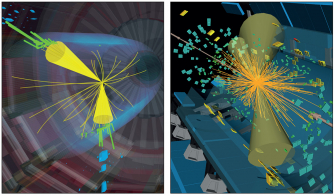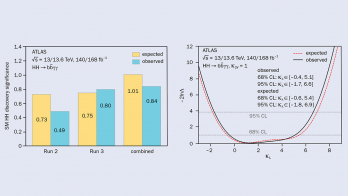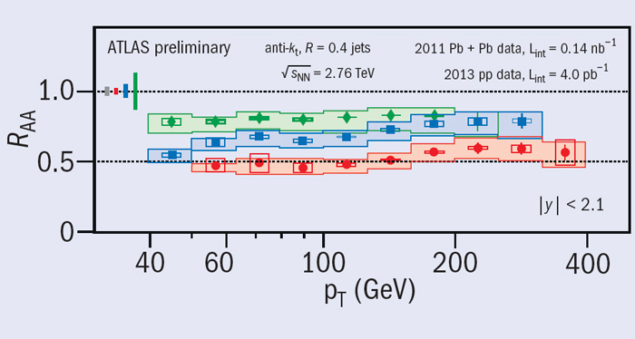
At the Quark Matter 2014 conference, held in Darmstadt on 19–25 May, ATLAS presented a variety of new results based on lead–lead (PbPb) and proton–lead (pPb) data collected during Run 1 of the LHC. The PbPb results included new measurements of event-by-event correlations and fluctuations of collective flow, high-statistics measurements of photon and W production, and studies of jet quenching using charged particles, single jets, nearby jet pairs and jet-fragmentation functions. The results from pPb data included precision measurements of long-range pseudorapidity correlation and associated azimuthal structures, and high-pT production of charged particles, Z bosons and jets. Here are some of the highlights.
Following the first observation of highly asymmetric dijets in PbPb collisions, the study of jet quenching has been an essential part of the heavy-ion physics programme at the LHC. Measurements of the production of electroweak bosons provide important control data for the study of jet quenching, as well as for investigating nuclear modifications to parton distribution functions. ATLAS presented new results on the measurement of W-boson production via the electron and muon decay modes in PbPb collisions at √sNN = 2.76 TeV, with yields of W bosons obtained as a function of centrality and pseudorapidity. A good agreement was found between the two decay channels. The yields are in agreement with the predictions based on modified next-to-leading-order calculations, while leading-order calculations underestimate the yield.
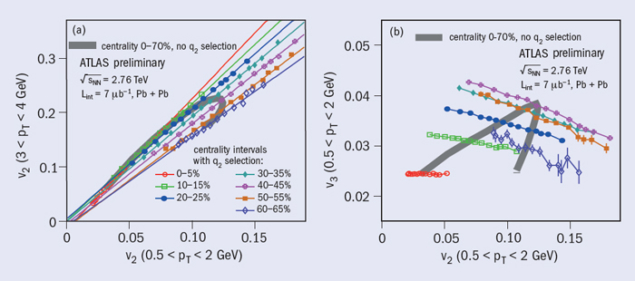
Jets produced in heavy-ion collisions can interact with the medium that is produced in the collisions and lose energy through the phenomenon of jet quenching. This energy loss suppresses the rate of jets produced in these collisions, relative to proton–proton collisions, where no such effects are present. Using the high-statistics proton–proton data set from 2013 as the new reference, ATLAS presented the most precise measurement of jet suppression to date. In central collisions, the jet yields are suppressed by more than a factor of two below a jet transverse momentum, pT, of around 150 GeV (see figure 1), but the suppression is found to be reduced at higher pT.
ATLAS presented first results on direct correlations between the elliptic flow coefficient, v2, and higher-order flow harmonics, v3, v4 and v5, in PbPb collisions. This correlation is obtained via an event-shape engineering technique, in which events within the same centrality interval are divided into different classes according to the observed ellipticity in the forward pseudorapidity. The correlation in v2 for two different ranges in pT (figure 2(a)) shows non-trivial centrality dependence but is linear within a narrow centrality interval. This linearity indicates that viscous effects are controlled by the size of the system, and not its overall shape. The v3–v2 correlations, shown in figure 2(b), reveal a surprising anticorrelation between the ellipticity and triangularity of the initial geometry, which is not accessible via the traditional measurements. The v4–v2 and v5–v2 correlations provide the most direct and detailed picture of the interplay between the linear and nonlinear collective dynamics in the final state of the PbPb collisions.
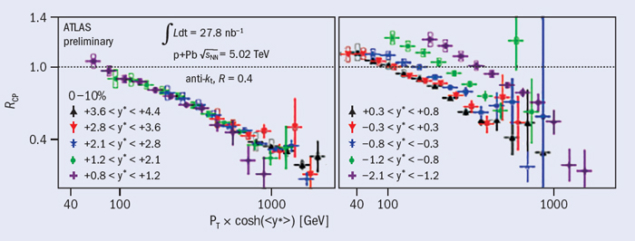
Turning to the pPb runs, the large data sample collected at √sNN = 5.02 TeV in 2013 allowed ATLAS to measure the jet production over the widest kinematic range ever probed in proton–nucleus collisions. This measurement has the potential to reveal how the hard partonic content inside matter is modified deep inside the high-density nucleus, and explores the interplay between hard processes and collision geometry – a major topic at the conference. When considering collisions of all impact parameters, the rate of jets was found to be slightly above what would be expected just from the proton’s collisions with individual nucleons in the lead nucleus. This slight excess is generally consistent with models of the modified parton densities in nuclei. However, when pPb collisions are selected by “centrality”, unexpected effects appear (figure 3). The rate of jets is suppressed strongly in apparently central events (with small impact parameter) and enhanced in those that appear peripheral (large impact parameter). Furthermore, the modifications of the jet rate have a striking pattern as a function of the energy and rapidity, implying that the modifications might originate in the proton, rather than the nuclear, wave function.

Using the same pPb data set, ATLAS also performed a detailed study of the long-range pseudorapidity correlation and its azimuthal structure, as characterized by the first five Fourier harmonics, v1–v5. The study extended the previous measurements at the LHC of v2 and v3 to higher pT and events with higher charged-particle multiplicities. Moreover, the measurements of v1, v4 and v5 were presented in this context for the first time. As figure 4 shows, the pT dependences of vn are found to be similar to PbPb collisions with comparable multiplicities, suggesting that the collective flow – the main attribute of the dense system created in PbPb collisions – might also be present in pPb interactions.
Further reading
For the full list of results presented by ATLAS at Quark Matter 2014, see https://twiki.cern.ch/twiki/bin/view/AtlasPublic/HeavyIonsPublicResults.






